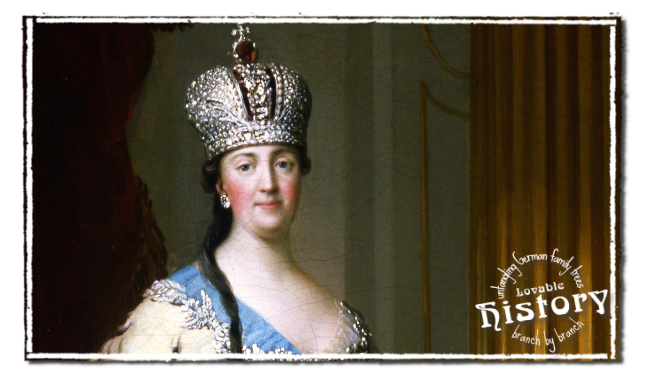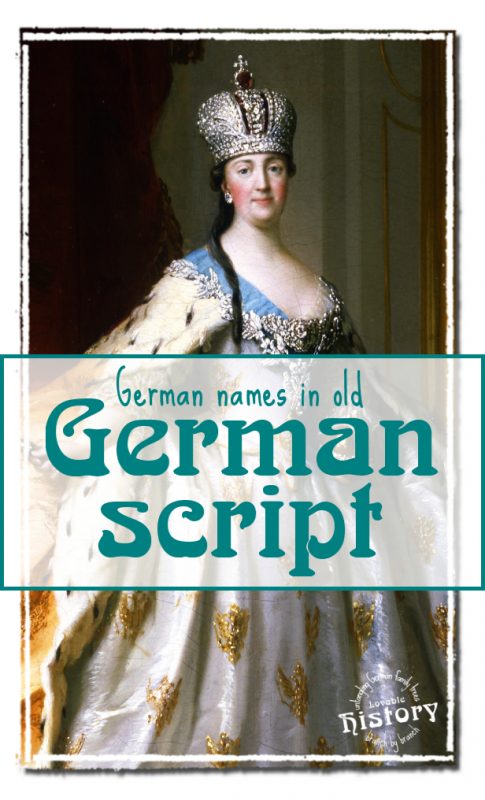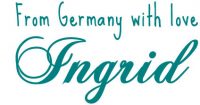This article is part of the series “Get Familiar With German Given Names In Old German Script” where you will find similar articles about other German names, including name variations and examples out of old documents. In this article we’ll deal with old German script Katharina or Catharina. Apparently there is a male version “Catharinus” as well but it’s only allowed in combination with another distictively male given name.
![]()

Some of the name variations are mainly used in certain German regions so it might well be that you’ll never ever see them in your own research. But according to the “better safe than sorry” it’s not one of the worst ideas to list them all, don’t you think? Please have a look at the incomplete list below.
Female variations
- Carin, Carina, Karen, Karin, Karina
- Catharina, Catarina, Catarine, Catharine, Catherina
- Katharina, Katarina, Katarine, Katharine, Katherina
- Cathrin, Cathrine, Catrin, Catrina, Catrine
- Kathrin, Kathrine, Katrin, Katrina, Katrine
- Ina
- Käthe
- Trine
Interesting name website
For more and international variations of Katharina please have a look at “Behind the name“, an incredible name website with more than 200k of names all over the world. Please also pay special attention to the very interesting internal links on the right side of their page:
- Expand Name Links
- See All Relations
- Show Family Tree
Examples of old German script: Katharina or Catharina
Now let’s have a look at the snippets I collected for you. Of course I don’t have a snippet for each and every possible variation but I’ll add them when I stumble over them.
Here and there you’ll notice that I meddled with the snippets. I erased all leftovers and cutoffs from other words and letters to make it easier for you to spot the single letters.
![Deciphering names in old German script just takes practice [www.lovablehistory.com]](http://www.lovablehistory.com/wp-content/uploads/2017/02/lovable-history-names-in-old-german-script-catharina01.png)
We’ll start easy. These are the first five versions of the name “Catharina”, all from a civil register around 1900. These five snippets show two variations: “Catharina” and “Catharine”
|
|
|
|
|
|
|
|
|
|
|
|
|
Can you spot which one the five snippets says “Catharine”? Compare the last letters! A Kurrent “e” very much looks like an “n” but the vertical strokes are much closer together and connected at the top with a tiny horizontal (or slightly diagonal) bar.
Sometimes the vertical strokes are so close together that you can’t even see that they are connected. (example e) Sometimes the connection isn’t there at all! Compare the letters “a” and “e”. In some handwritten documents you won’t even be able to decide whether the last letter is an “a” or an “e”… However, that depends on the writer, really, don’t feel bad about that. Just work as accurately as you are able to.
![]()
![Deciphering names in old German script just takes practice [www.lovablehistory.com]](http://www.lovablehistory.com/wp-content/uploads/2017/05/lovable-history-old-german-script-katharina01.jpg) Here you see five variations of the name “Katharina”, copied from church registers around 1800. Even though it doesn’t matter for the pronounciation in German, please don’t transcribe this variation with “Catharina” or “Catherine”. Always use the original spelling in the source!
Here you see five variations of the name “Katharina”, copied from church registers around 1800. Even though it doesn’t matter for the pronounciation in German, please don’t transcribe this variation with “Catharina” or “Catherine”. Always use the original spelling in the source!
- I’ve highlighted the “a” in every name so you can compare them with each other and learn to identify this letter with the (theoretically round and open) circle and the downstroke after that.
- In the right column you see two snippets with a fairly decent Kurrent “K”. Yes, that’s a “K” and not an “R”! Always keep that in mind: whenever you think a capital letter looks like an “R”, consider the option of a “K” as well.
- Also pay attention to the “t” in the right column snippets. The priests didn’t really write a bottom loop for the “t”. Both almost look like an “f”, just without the squirl or bar which is typical for the “f”.
- In the left column you’ll find nastier variations of the Kurrent “K” (and some other letters as well). My suggestion is to skip the capital letter in the beginning if you aren’t sure. Then decipher and transcribe the rest of the word as far as you’re able to. After that give both options (“K” and “R”) a try to see which one makes sense. Even for me it’s not always clear if a capital letter is a “K” or an “R”, especially if I don’t have any other words to compare. Depends on the writer’s chicken scratch… Just have a go at it!
- The priests who wrote the names in the left column snippets were less sloppy with the “t” bottom loop. Still all three letters look slightly different.
![]()
More snippets with other variations are on their way, please check back now and then for new additions. Come time, come snippets…
![]()
Katharina, Catherine and its variations have been quite common in Germany and still are. I just counted how many of my female relatives carry one of the name variations (ok, ok, I just had my software do that…). It turns out that about 7 % of the women had or have that name, either as only given name or in combination with other given names. Pretty interesting number for me. What about your family and relatives and ancestors?

![]()

Leave a Reply